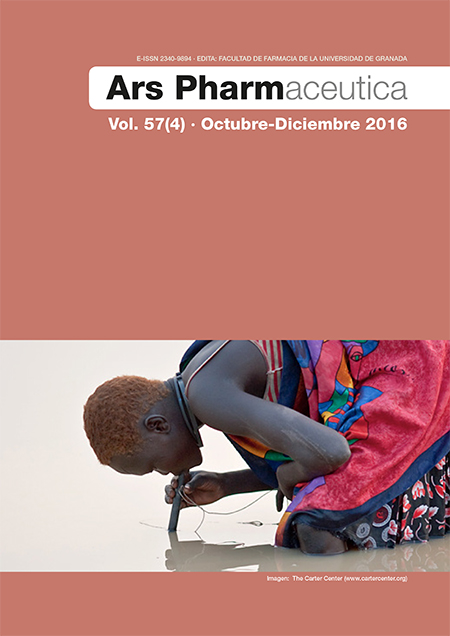Studies of ternary systems of sulfadiazine with β-cyclodextrin and aminoacids
DOI:
https://doi.org/10.30827/ars.v57i4.5561Keywords:
sulfadiazine, complexation, β-cyclodextrin, ternary systems, aminoacidAbstract
Introduction: Cyclodextrins (CD), are known to form inclusion complexes with a variety of guest molecules both in solution and in the solid state. This can lead to the alteration of properties of guest molecules. Unfortunately, the complexation efficiency of CD is rather low, and can be enhanced by formation of ternary complexes using aminoacids (AA). Sulfadiazine (SDZ) is an antibiotic with extremely low water solubility which limits its therapeutic applications and bioavailability.
Objetives: The aim of this work was to increase the aqueous solubility of SDZ by preparing ternary complexes of this drug with β-cyclodextrin (βCD) and an AA as a third auxiliary substance.
Materials y Methods: Complex formation was studied by phase solubility analysis (PSA), nuclear magnetic resonance (NMR), differential scanning calorimetry (DSC), thermogravimetric analysis (TG) and scanning electron microscopy (SEM).
Results: The apparent stability constants (KC) of the multicomponent complexes were calculated from the solubility diagrams. By the analysis of the NMR spectra, it could be said that the shifts of some protons evidenced the important role of the AA in the formation of multicomponent complexes. Among the AA, Arginine (ARG) proved to have better solubilizing properties for SDZ, reaching an improvement up to 70 times. The use of DSC, TG and SEM suggested the formation of new solid phases between SDZ:βCD:AA.
Conclusions: As a result of this research, it was determined that ternary products were more effective in improving drug solubility than the corresponding SDZ:βCD binary system.
Downloads
References
Stella VJ, Rajewski RA. Cyclodextrins: Their future in drug formulation and delivery. Pharm Res. 1997;14(5):556-67.
Huang Y, Zu Y, Zhao X, Wu M, Feng Z, Deng Y, Zu C, Wang L. Preparation of inclusion complex of apigenin-hydroxypropyl-β-cyclodextrin by using supercritical antisolvent process for dissolution and bioavailability enhancement. Int J Pharm. 2016;511(2):921-30.
Santos C, Teijeiro C, Ribeiro A, Rodrigues D, Romero C, Esteso M. Drug delivery systems: Study of inclusion complex formation for ternary caffeine–β-cyclodextrin–water mixtures from apparent molar volume values at 298.15 K and 310.15 K. J Mol Liq. 2016;223:209-16.
Aiassa V, Zoppi A, Albesa I, Longhi MR. Inclusion complexes of chloramphenicol with β-cyclodextrin and aminoacids as a way to increase drug solubility and modulate ROS production. Carbohydr Polym. 2015;121:320-7.
Aloisio C, de Oliveira AG, Longhi M. Solubility and release modulation effect of sulfamerazine ternary complexes with cyclodextrins and meglumine. J Pharm Biomed Anal. 2014;100:64-73.
Garnero C, Longhi M. Development of HPLC and UV spectrophotometric methods for the determination of ascorbic acid using hydroxypropyl-β-cyclodextrin and triethanolamine as photostabilizing agents. Anal Chim Acta. 2010;659(1-2):159-66.
Granero GE, Garnero C, Longhi MR. The effect of pH and triethanolamine on sulfisoxazole complexation with hydroxypropyl-β-cyclodextrin. Eur J Pharm Sci. 2003;20(3):285-93.
Granero GE, Maitre MM, Garnero C, Longhi MR. Synthesis, characterization and in vitro release studies of a new acetazolamide-HP-β-CD-TEA inclusion complex. Eur J Med Chem. 2008;43(3):464-70.
Mennini N, Maestrelli F, Cirri M, Mura P. Analysis of physicochemical properties of ternary systems of oxaprozin with randomly methylated-ß-cyclodextrin and l-arginine aimed to improve the drug solubility. J Pharm Biomed Anal. 2016;129(10):350-58.
Roy M, Roy A, Saha S. Probing inclusion complexes of cyclodextrins with amino acids by physicochemical approach. Carb Pol. 2016;151(20):458-66.
Connor EE. Sulfonamide antibiotics. Primary Care Update for Ob/Gyns. 1998;5(1):32-5.
Molinoff PB, Ruddon RW. Goodman and Gilman’s: The Pharmacological Basis of Therapeutics. 9 ed. New York, USA: Pergamon Press; 1996.
Sweetman SC, Blake PS. Martindale: The Complete Drug Reference. 36 ed. London, UK: Pharmaceutical Press; 2009.
Stober H, DeWitte W. Sulfadiazine. Analytical Profiles of Drug Substances and Excipients. Mildford, USA: Center for Pharmaceutical Physics; 1982. p. 523-51.
Araújo MVGd, Vieira EKB, Silva Lázaro G, Conegero LS, Almeida LE, Barreto LS, et al. Sulfadiazine/hydroxypropyl-β-cyclodextrin host-guest system: Characterization, phase-solubility and molecular modeling. Bioorg Med Chem. 2008;16(10):5788-94.
Delrivo A, Zoppi A, Longhi MR. Interaction of sulfadiazine with cyclodextrins in aqueous solution and solid state. Carbohydr Polym. 2012;87(3):1980-8.
Zoppi A, Quevedo MA, Delrivo A, Longhi MR. Complexation of sulfonamides with beta-cyclodextrin studied by experimental and theoretical methods. J Pharm Sci. 2010;99(7):3166-76.
Higuchi T, Connors KA. Phase-solubility techniques. Adv Anal Chem Instr. 1965;4:117-212.
Frömming KH, Szejtli J. Cyclodextrins in Pharmacy. Dordrecht, The Netherlands: Kluwer Academic Publishers; 1994. p. 58-60.
Salústio PJ, Feio G, Figueirinhas JL, Pinto JF, Cabral Marques HM. The influence of the preparation methods on the inclusion of model drugs in a β-cyclodextrin cavity. Eur J Pharm Biopharm. 2009;71(2):377-86.
Downloads
Published
How to Cite
Issue
Section
License
The articles, which are published in this journal, are subject to the following terms in relation to the rights of patrimonial or exploitation:
- The authors will keep their copyright and guarantee to the journal the right of first publication of their work, which will be distributed with a Creative Commons BY-NC-SA 4.0 license that allows third parties to reuse the work whenever its author, quote the original source and do not make commercial use of it.
b. The authors may adopt other non-exclusive licensing agreements for the distribution of the published version of the work (e.g., deposit it in an institutional telematic file or publish it in a monographic volume) provided that the original source of its publication is indicated.
c. Authors are allowed and advised to disseminate their work through the Internet (e.g. in institutional repositories or on their website) before and during the submission process, which can produce interesting exchanges and increase citations of the published work. (See The effect of open access).























